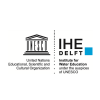Interview with Ioana Popescu, Associate Professor of Hydroinformatics at IHE Delft Institute for Water Education
Please describe how your professional (and/or personal) experience relates to space technologies and their applications to water resources management.
I am an expert in hydroinformatics, mainly involved in research projects and research supervision of MSc and PhD students. My research focusses on physically based models for inland waters (rivers and lakes). One of the major fields where modelling is used in water resources is flooding. In order to have adequate representation of floods, most models require large amounts of data, both for model building and model usage.












